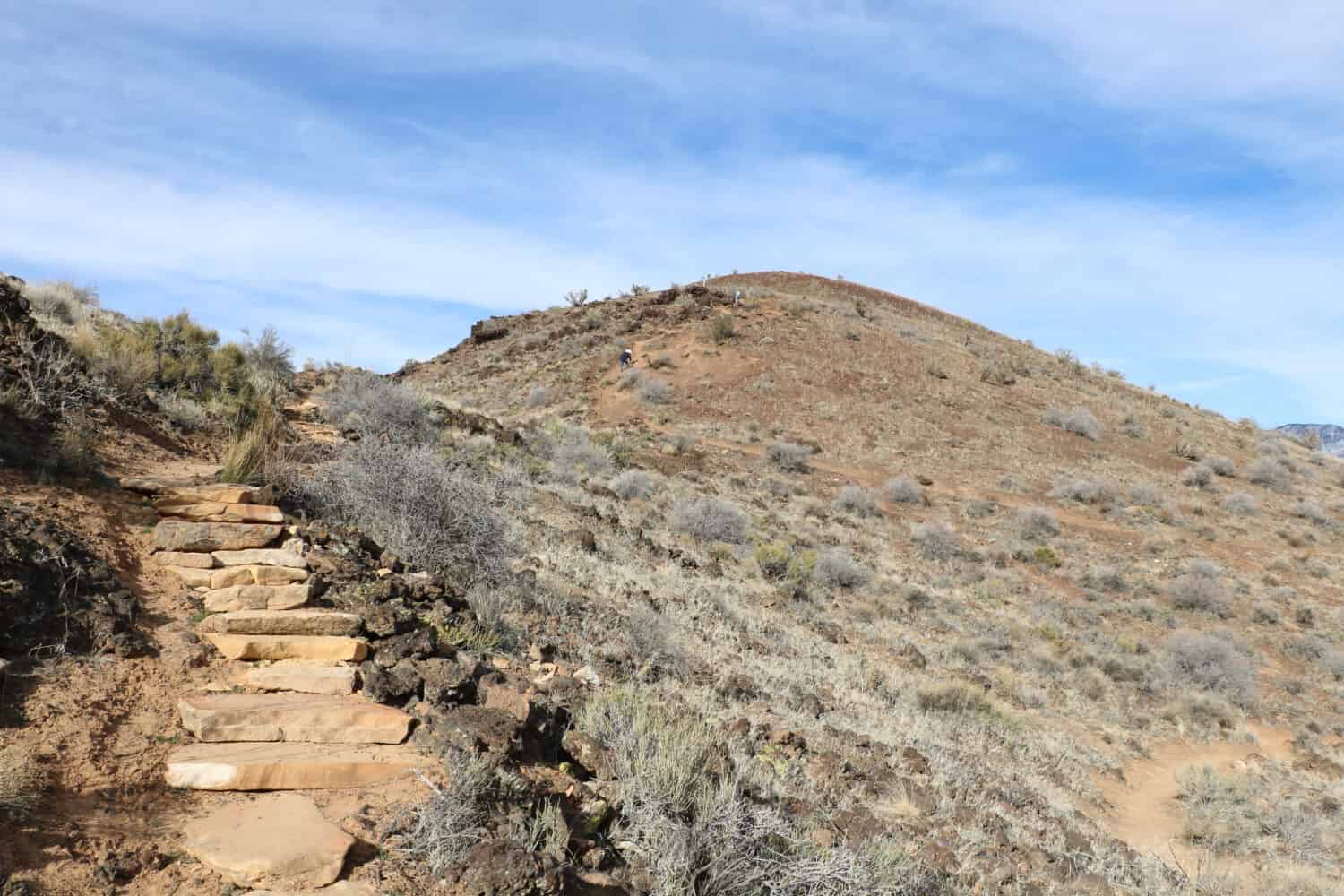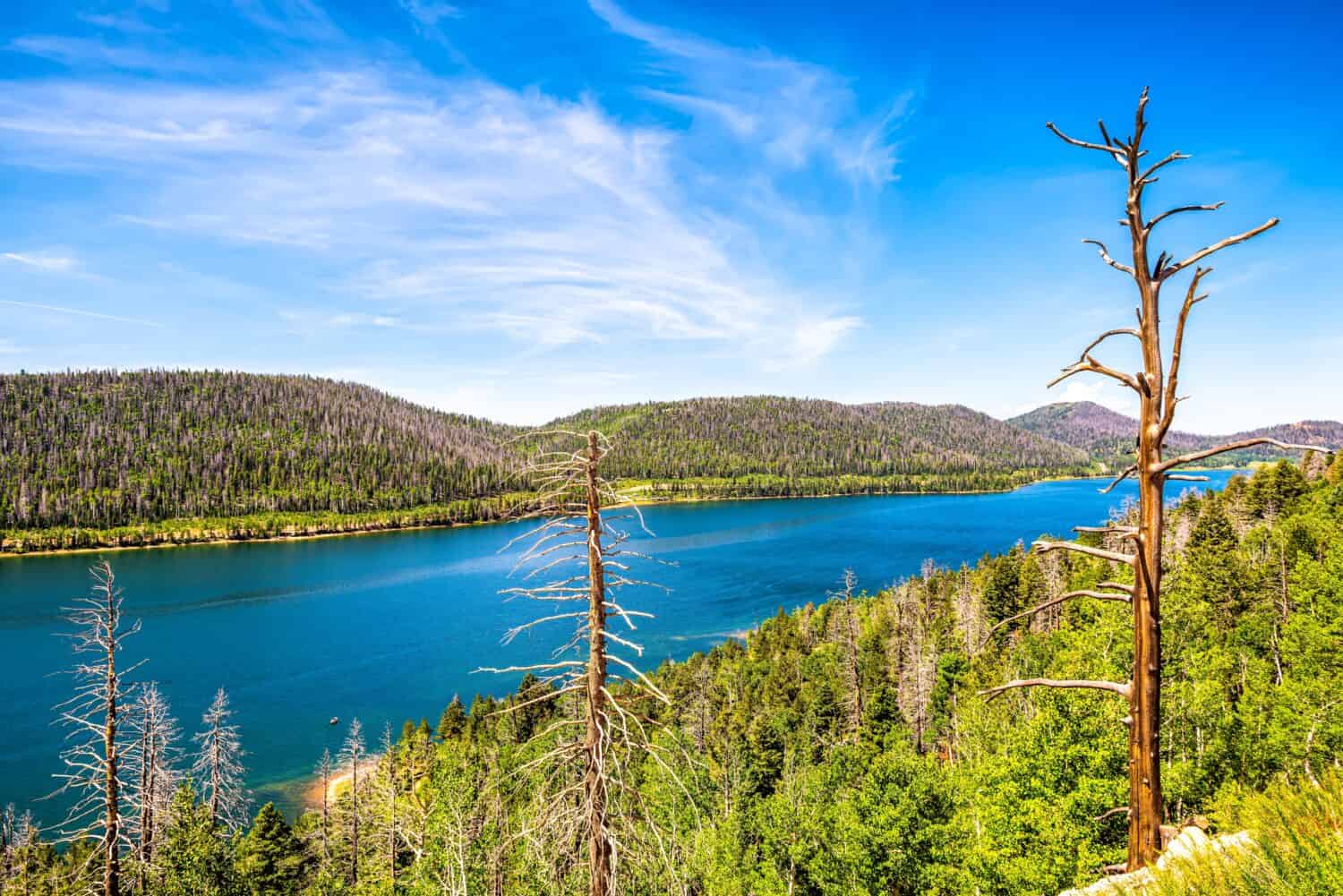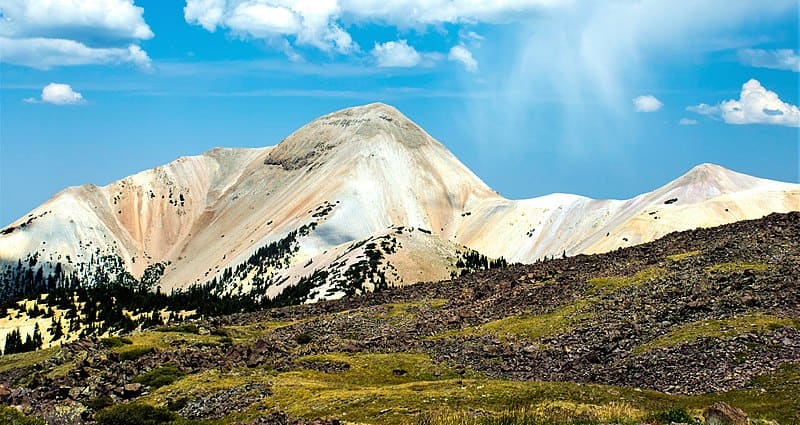As a state in the Mountain West region, it’s not surprising that Utah has some impressive mountains, with Kings Peak standing at an impressive 13,123 feet tall. However, the state has also been the site of much volcanic activity over the last few million years. Some of the most common types of volcanoes in the area are cinder cones and stratovolcanoes, with sizes which vary from only a few hundred feet high to several thousand. So, let’s discover the tallest volcanoes in Utah!

5. Santa Clara Volcanic Field — 4,806 feet

The Cinder Cone Trail is a 1.7 mile hike around the southern cinder cone in the Santa Clara Volcanic Field.
©salilbhatt/Shutterstock.com
The first volcano on our list is the Santa Clara Volcanic Field which is located in the Diamond Valley in Washington County. This volcanic field has been active for approximately four million years and features two cinder cones, with the tallest point being 4,806 feet high. It also has numerous areas of stunning black lava rock, with estimations putting some of the youngest lava flows at only 10 to 20,000 years old. The southern cinder cone and the majority of the northern one lie within Snow Canyon State Park. The area is popular with hikers, particularly the Cinder Cone Trail which is a 1.7 mile hike around the southern cone. Once at the top it is possible to walk around the entire rim of the cone which offers spectacular views of the surrounding area.
4. Black Rock Desert Volcanic Field — 5,904 feet

The lava flow from the volcanoes in Black Rock Desert have created many unusual formations.
©JULIA Culp/Shutterstock.com
Next, we have the Black Rock Desert Volcanic Field which covers approximately 700 square miles in Millard County. This volcanic field is comprised of several volcanic features, with the highest standing at 5,904 feet tall. The Black Rock Desert area features several volcanic cones, pressure ridges, and lava flows. It is thought to be the sight of the most recent volcanic activity in Utah. The last eruption was approximately 10,000 years ago and led to the formation of basalt cinder cones in an area now known as the “Ice Springs”. However, the latest activity was just 600 years ago when there was a new lava flow there. The lava flows in the Ice Springs area span 17 square miles and are covered with dark volcanic rock.
The Black Rock Desert area is a popular place to visit and can be accessed relatively easily from I-15. However, both Pahvant Butte and Tabernacle Hill are classed as Areas of Critical Environmental Concern due to their unique features and historical importance.
3. Bald Knoll — 7,005 feet

Bald Knoll has a lava flow which extends 7.5 miles from it.
©Lee Siebert, Public domain, via Wikimedia Commons – License
The third tallest volcano in Utah is Bald Knoll which stands at 7,005 feet. Bald Knoll is a cinder cone volcano and is the youngest in the southwestern region of the Paunsaugunt Plateau. It is made from basaltic lava and has an impressive lava flow which extends approximately 7.5 miles to the southeast. It is not known when Bald Knoll last erupted. However, estimations suggest that it was only a few thousand years ago, based on its intact crater which is 920 feet wide. Bald Knoll is located between Bryce Canyon National Park and the Grand Staircase-Escalante National Monument.
2. Markagunt Plateau Volcanic Field — 9,318 feet

Navajo Lake was formed by the lava flows from the volcanoes in the Markagunt Plateau Volcanic Field.
©Andriy Blokhin/Shutterstock.com
Markagunt Plateau is another large volcanic field which covers 1,160 square miles in southern Utah, with the highest point being 9,318 feet. The volcanic field consists of lava flows and around 25 cinder cone volcanoes. Some of the lava flows have created lakes, including Navajo Lake and Duck Lake. It is not known when the last eruption occurred. Estimations suggest that some of the cinder cones are less than 10,000 years old. However, the earliest volcanic activity in the area occurred approximately 5.3 million years ago. Much of the area is situated within the Dixie National Forest and includes trees such as aspen, fir, juniper, and spruce.
1. Mount Belknap — 12,137 feet

Mount Belknap is one of the most challenging places to hike in Utah due to its loose scree slopes.
©Intermountain Forest Service, USDA Region 4 Photography, Public domain, via Wikimedia Commons – License
The tallest volcano in Utah is Mount Belknap which has a height of 12,137 feet. It is located in Marysvale Volcanic Field which one of the largest volcanic areas in the western region of the US and spans around 3,000 square miles. Marysvale is situated on the Colorado Plateau-Great Basin transition zone and features cinder cones, stratovolcanoes, calderas, and lava flows. It has many igneous rocks which were formed between 32 and 22 million years ago. It also has basalt and rhyolite rocks which range from 23 million years ago to the Holocene epoch.
Mount Belknap is the second-highest peak in the Tushar Mountains. Is a popular, albeit challenging place to hike due to the steep, loose scree slopes. Mount Belknap was formerly used as a heliograph station and there are still several old huts present on the west side of the mountain, close to the summit. There are several species of plants and animals on the mountain. However, one of the rarest is Draba ramulosa which is also known as Mount Belknap draba. This is a flowering plant which is endemic to Mount Belknap and flowers from June to August.
Summary of the 5 Tallest Volcanoes in Utah
| Rank | Volcano | Height |
|---|---|---|
| 1 | Mount Belkap | 12,137 feet |
| 2 | Markagunt Plateau Volcanic Field | 9,318 feet |
| 3 | Bald Knoll | 7,005 feet |
| 4 | Black Rock Desert Volcanic Field | 5,904 feet |
| 5 | Santa Clara Volcanic Field | 4,806 feet |
The photo featured at the top of this post is © Claudio Del Luongo/Shutterstock.com
Thank you for reading! Have some feedback for us? Contact the AZ Animals editorial team.






